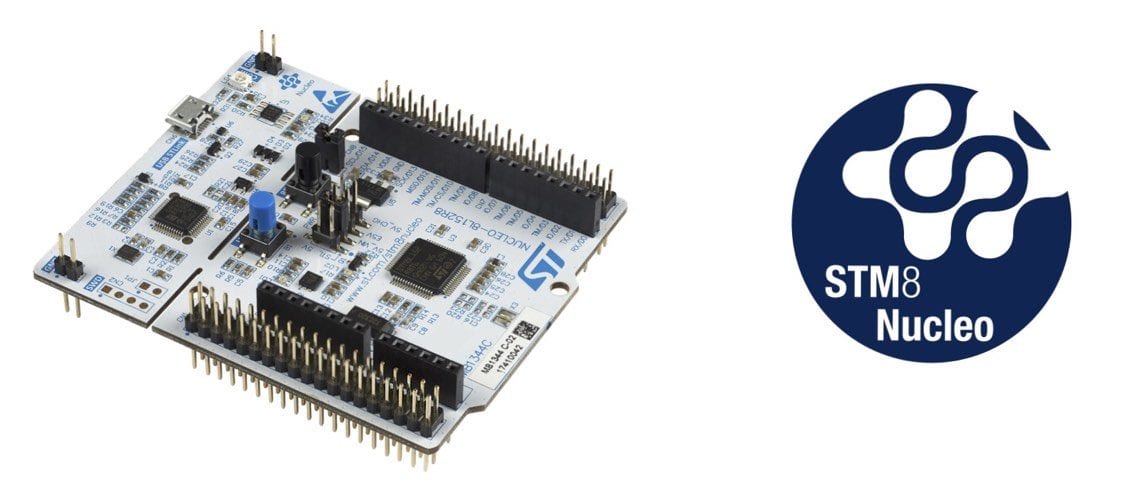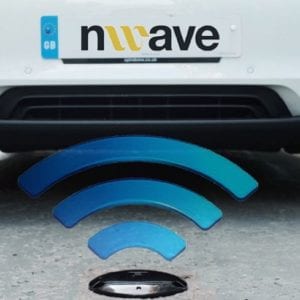The NUCLEO-8L152R8 and the NUCLEO-8S208RB are the first Nucleo-64 boards integrating an STM8 microcontroller (MCU), enabling flexible prototyping with slim MCU configurations. The significant difference between the two models resides in their amount of Flash memory. The former integrates the STM8L152R8T6 MCU with a capacity of 64 kB while the latter uses the STM8S208RBT6 that embarks 128 kB of storage. They are also the first STM8 development boards with an ArduinoTM Uno V3 connector, allowing developers to use familiar extension cards, free plugins, and popular programming paradigms. Furthermore, since we also partnered with Cosmic to offer a free compiler with the STVD-STM8 IDE or Arduino IDE, it’s the first time that developers can use C++ to develop software for our STM8 MCUs without having to buy a toolchain.
Our STM32 Nucleo boards are particularly popular because they facilitate prototyping and developments. They also have an extensive selection of expansion boards, which are now compatible with the NUCLEO-8L152R8 and the NUCLEO-8S208RB since all Nucleo models offer an Arduino connector. It means that engineering teams can reuse the same hardware, which will help them save costs, but more importantly reduce development times since they are already familiar with the expansions they will stack on top the new STM8 Nucleo boards. As a result, it is now easier to add features to our 8-bit systems, enabling more complex and smarter designs in increasingly smaller packages. And to help developers, we released various application notes showing how to start multiple projects on this new platform.
Doing More with the STM8
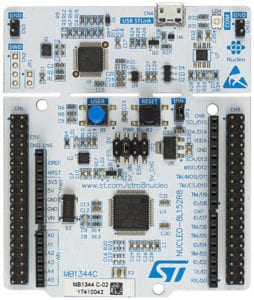
We published Application Notes on the product page of each new board to jump-start developments. For instance, Application Note 5182 shows how to use an Adafruit 1.8″ TFT shield with the NUCLEO-8L152R8 or the NUCLEO-8S208RB, how to install it on the UNO connector, and how to import our source files into a toolchain to create a software that can display a 128 x 60 image.
Additionally, there’s an onboard ST-LINK/V2 debugger that brings a Virtual COM port for the first time in our STM8 ecosystem. As a result, users do not need an additional probe and can connect the board to their PC to load their application from their IDE or by dragging and dropping a binary onto the board’s storage volume. Moreover, designers can use a terminal application to send commands or monitor information, making this an exciting device for engineering teams as well as enthusiasts.
Just like with all the STM32 Nucleo boards before, the new STM8 ones also have an ST morpho header that enables developers to access all the pins of the microcontroller, unlike the Arduino connector that has far more restrictions by nature. Developers can thus use all the I/Os to manage the peripherals of the device and design prototypes that take advantage of the entire platform. This is particularly useful when using breadboards or external cards that must connect to specific pins. It also dramatically helps engineers who will later have to design their own custom PCB, as it gives them a great view of what to expect when using any combination of the STM8 MCU resources.
Doing Better with the STM8 Nucleo Boards
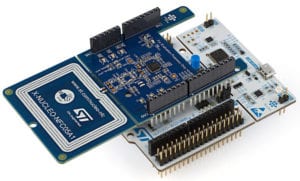
We also improved our ecosystem by porting the NFC software package for the X-NUCLEO-NFC05A1 NFC expansion board to the STM8 architecture. It’s thus possible to install this card on top of an STM8 Nucleo system, import the source code of the STSW-STM8-NFC5 package in an IDE to test a demo application, and start experimenting with the stack in minutes.
Let’s take the ST25R3914, an NFC/HF RFID reader that obtained an AEC-Q100 grade 1 qualification, which means it is suitable for automotive applications. Car manufacturers can thus use it as a key replacement to enable users to open and start their vehicle by just a smartphone or a smartwatch. One of the challenges is that the system must reside in a tiny space, such as the back of a door handle or on the front console.
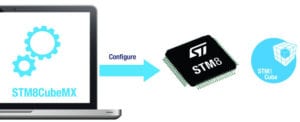
Thanks to the two new STM8 Nucleo boards, any company can use our expansion board and software to create a smaller product that meets these challenges. And since engineers can access all the I/Os of the microcontroller, it’s a breeze to switch to a custom PCB with the version of the STM8 MCU that also received an AEC-Q100 certification. Developers can transition from the new part number without having to massively rewrite their code, thanks to STM8CubeMX, which will generate the new header files.
We also have a new repository that adds support for the Arduino platform to the STM8 architecture, and that developers can call with Arduino Boards Manager. They can take full advantage of the Arduino environment on STM8 microcontrollers, leveraging the free Cosmic compiler, thus removing the need to go through third-party projects that rely on Small Devices C Compiler (SDCC).
The Lucky Number
The first STM8 Nucleo boards, the NUCLEO-8L152R8, and the NUCLEO-8S208RB, are already available at various resellers or on the ST website at €8,8 or about US$10. Beyond the symbolism of the number 8, it was our mission to make them as accessible and affordable as possible to open developers to an entirely new ecosystem that brings unique features to the world of 8-bit microcontrollers, and we can’t wait to see what the community will do with these new possibilities.


